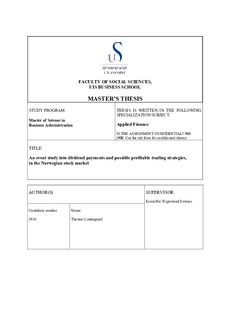| dc.contributor.advisor | Eriksen, Kristoffer Wigestrand | |
| dc.contributor.author | Lundegaard, Thomas | |
| dc.date.accessioned | 2018-09-19T13:19:30Z | |
| dc.date.available | 2018-09-19T13:19:30Z | |
| dc.date.issued | 2018-06-14 | |
| dc.identifier.uri | http://hdl.handle.net/11250/2563486 | |
| dc.description | Master's thesis in Applied Finance. | nb_NO |
| dc.description.abstract | This Thesis contains a detailed event analysis where market efficiency in the event of dividend pay-outs in the Norwegian stock market is analysed. The event analysis uses two introduced main hypothesis’ in the form of trading strategies to establish whether either can obtain abnormal returns. This is, excess return beyond the normal return that is to be expected based on the stocks previous correlation to the market movements.
Hypothesis 1, the dividend inclusive strategy targets the period between the dividend announcement and the ex-dividend date. This follows from the assumption that abnormal stock price movements happen after the announcement of dividend, and that investor preferences might influence the efficiency of the stock price in this period. Hypothesis 2, the ex-dividend strategy targets the period after the ex-dividend date. The hypothesis is that stocks is inefficient after the ex-dividend date due to investor preferences and that the stock price returns to efficiency after an unknown time period. The ending date for the ex-dividend strategy is calculated using the risk adjusted return of the stocks in the sample. The optimal ending time is calculated to be nine days after the ex-dividend date as it has the highest cumulative abnormal return.
The analysis shows that both individual trading strategies as well as both collectively has positive cumulative average abnormal returns. However, the CAAR’s are small and paired with the respective standard deviations, the significance tests reveal that they are not significant at a meaningful level of confidence.
Although the abnormal returns for the trading strategies were not significant, the event study give additional support to existing theories such as the market efficiency theory (1970) and dividend irrelevancy (Miller & Modigliani, 1961). The data material also revealed elevated volatility in the days following the ex-dividend date. This justifies a strong encouragement for future research to establish the cause and implications of such. Finally, the recent introduction of new taxation arrangement concerning private investors in Norway might change investors preferences concerning dividend going forward. This is also an important subject for future research in the field when sufficient data becomes available. | nb_NO |
| dc.language.iso | eng | nb_NO |
| dc.publisher | University of Stavanger, Norway | nb_NO |
| dc.relation.ispartofseries | Masteroppgave/UIS-HH/2018; | |
| dc.subject | økonomi | nb_NO |
| dc.subject | administrasjon | nb_NO |
| dc.subject | event studie | nb_NO |
| dc.subject | finans | nb_NO |
| dc.subject | markedseffisiens | nb_NO |
| dc.subject | anvendt finans | nb_NO |
| dc.subject | Oslo Børs | nb_NO |
| dc.title | An Event Study Into Dividend Payments and Possible Profitable Trading Strategies, in the Norwegian Stock Market | nb_NO |
| dc.type | Master thesis | nb_NO |
| dc.subject.nsi | VDP::Samfunnsvitenskap: 200::Økonomi: 210::Bedriftsøkonomi: 213 | nb_NO |
